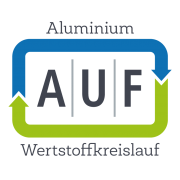A|U|F recycling initiative is role model for Europe
The environmentally friendly and resource-conserving use of building materials is increasing all the time. Raw materials, primary metals and energy are becoming more expensive – the importance of recycled materials is growing. Aluminium has recycling qualities that no other metal can match. This is one of the reasons why the Aluminium und Umwelt im Fenster- und Fassadenbau (A|U|F, Aluminium and Environment in Window and Façade Construction) recycling initiative, which is dedicated to aluminium recycling in the construction sector, was founded 25 years ago.
The A|U|F initiative’s aim is to return used aluminium from building applications, especially windows, doors and façades, to a closed material loop and thus ensure that used aluminium components are recycled and processed into profiles for building applications again. “With the A|U|F collection system, we want to keep the high-quality and much soughtafter aluminium alloys from scrap building materials in a closed loop,” explains A|U|F’s chairman Walter Lonsinger. New patented sorting techniques for processing used scrap mean it is now possible to produce aluminium alloys for building applications that contain up to 90 per cent recycled material. This means only a small proportion of unalloyed aluminium is then needed to ensure the new window or façade profiles produced have the desired material properties. “Aluminium profiles used in window and façade construction are high-quality alloys,” Walter Lonsinger adds. “If the material is transferred to other recycling loops, we will lose it.” This means, for example, that if aluminium scrap is exported to China or India on a oneway ticket, it will no longer be available for use in Europe, where the aim is to increase the proportion of aluminium products recycled. The initiative increases market transparency and at the same time streng – thens the European economy because the material stays within Europe. This is also one reason why EA, the European aluminium association, wants to extend the A|U|F model to the rest of Europe.
More than 200 members
A|U|F now has 206 member companies, including system houses, metal fabricators and planning offices. In addition, the initiative can rely on eleven environmental partners with over 270 collection centres. The acquisition of new members is carried out partly by the affiliated system houses, but also because companies want to support the A|U|F initiative and its aims and at the same time want to demonstrate that they are practicing sustainability proactively and not just talking about it.
The members undertake to return any aluminium scrap they produce to the material loop. “In concrete terms, this means that the companies collect any profile offcuts and chips arising during production, as well as components and profiles that have been removed during demolition and gutting operations,” explains the A|U|F’s chairman. “This aluminium scrap is purchased at fair market prices from our environmental and collection partners, where it is shredded, separated according to type and processed. Foundries melt the material down into billets, which extrusion plants then process again into highquality aluminium profiles for window and façade construction, thus creating a closed loop.”
Volume collected increasing continuously
The A|U|F is growing continuously. Of a total of some 95,000 tonnes of aluminium scrap produced annually in Germany in the building sector, almost every third tonne is currently processed into windows, façades or other aluminium components again in accordance with A|U|F’s regulations as part of a closed and monitored recycling process. In 2017, A|U|F collected and recycled 30,525 tonnes of aluminium scrap; around 18,000 tonnes of aluminium scrap was already fed into the closed loop in the first half of 2019. That is about 30 to 35 percent of the aluminium scrap generated in Germany from the windows, doors and façades sector. The A|U|F initiative enjoys a good reputation in the building and construction industry. For more and more tenders for façades, windows or doors, architects are now demanding concrete proof of the qualified material oop that has been used. A|U|F members have no problem providing such proof: a certificate issued annually provides the warding authorities with proof that the company participates in the product-related recycling process. Walter Lonsinger has the future firmly in his sights: “We want to acquire more members and convince them that closed material loops in Germany and other European countries are a must if we are to have optimum recycling and thus help avoid restrictions or bans on the use of aluminium.” At the same time, A|U|F wants to work with decision-makers, investors, building owners, architects and planning departments to ensure that suppliers of metal construction services can prove that they participate in a closed material loop. The aim is to work together in future to bring even more scrap into the closed loop.





 Pixaby © Alexas_Fotos
Pixaby © Alexas_Fotos